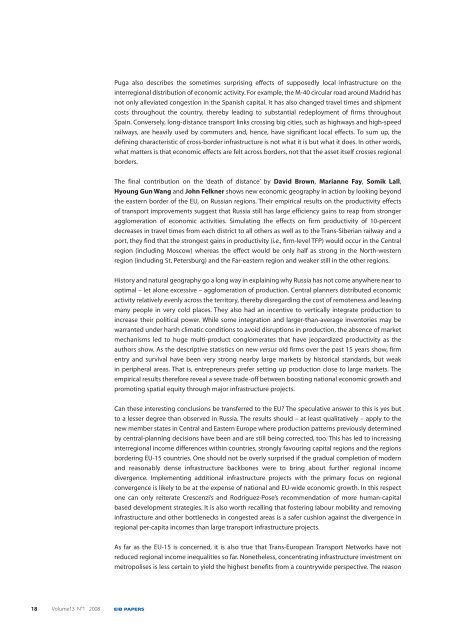EIB Papers Volume 13. n°1/2008 - European Investment Bank
EIB Papers Volume 13. n°1/2008 - European Investment Bank
EIB Papers Volume 13. n°1/2008 - European Investment Bank
You also want an ePaper? Increase the reach of your titles
YUMPU automatically turns print PDFs into web optimized ePapers that Google loves.
18 <strong>Volume</strong>13 N°1 <strong>2008</strong> <strong>EIB</strong> PAPERS<br />
Puga also describes the sometimes surprising effects of supposedly local infrastructure on the<br />
interregional distribution of economic activity. For example, the M-40 circular road around Madrid has<br />
not only alleviated congestion in the Spanish capital. It has also changed travel times and shipment<br />
costs throughout the country, thereby leading to substantial redeployment of firms throughout<br />
Spain. Conversely, long-distance transport links crossing big cities, such as highways and high-speed<br />
railways, are heavily used by commuters and, hence, have significant local effects. To sum up, the<br />
defining characteristic of cross-border infrastructure is not what it is but what it does. In other words,<br />
what matters is that economic effects are felt across borders, not that the asset itself crosses regional<br />
borders.<br />
The final contribution on the ‘death of distance’ by David Brown, Marianne Fay, Somik Lall,<br />
Hyoung Gun Wang and John Felkner shows new economic geography in action by looking beyond<br />
the eastern border of the EU, on Russian regions. Their empirical results on the productivity effects<br />
of transport improvements suggest that Russia still has large efficiency gains to reap from stronger<br />
agglomeration of economic activities. Simulating the effects on firm productivity of 10-percent<br />
decreases in travel times from each district to all others as well as to the Trans-Siberian railway and a<br />
port, they find that the strongest gains in productivity (i.e., firm-level TFP) would occur in the Central<br />
region (including Moscow) whereas the effect would be only half as strong in the North-western<br />
region (including St. Petersburg) and the Far-eastern region and weaker still in the other regions.<br />
History and natural geography go a long way in explaining why Russia has not come anywhere near to<br />
optimal – let alone excessive – agglomeration of production. Central planners distributed economic<br />
activity relatively evenly across the territory, thereby disregarding the cost of remoteness and leaving<br />
many people in very cold places. They also had an incentive to vertically integrate production to<br />
increase their political power. While some integration and larger-than-average inventories may be<br />
warranted under harsh climatic conditions to avoid disruptions in production, the absence of market<br />
mechanisms led to huge multi-product conglomerates that have jeopardized productivity as the<br />
authors show. As the descriptive statistics on new versus old firms over the past 15 years show, firm<br />
entry and survival have been very strong nearby large markets by historical standards, but weak<br />
in peripheral areas. That is, entrepreneurs prefer setting up production close to large markets. The<br />
empirical results therefore reveal a severe trade-off between boosting national economic growth and<br />
promoting spatial equity through major infrastructure projects.<br />
Can these interesting conclusions be transferred to the EU? The speculative answer to this is yes but<br />
to a lesser degree than observed in Russia. The results should – at least qualitatively – apply to the<br />
new member states in Central and Eastern Europe where production patterns previously determined<br />
by central-planning decisions have been and are still being corrected, too. This has led to increasing<br />
interregional income differences within countries, strongly favouring capital regions and the regions<br />
bordering EU-15 countries. One should not be overly surprised if the gradual completion of modern<br />
and reasonably dense infrastructure backbones were to bring about further regional income<br />
divergence. Implementing additional infrastructure projects with the primary focus on regional<br />
convergence is likely to be at the expense of national and EU-wide economic growth. In this respect<br />
one can only reiterate Crescenzi’s and Rodríguez-Pose’s recommendation of more human-capital<br />
based development strategies. It is also worth recalling that fostering labour mobility and removing<br />
infrastructure and other bottlenecks in congested areas is a safer cushion against the divergence in<br />
regional per-capita incomes than large transport infrastructure projects.<br />
As far as the EU-15 is concerned, it is also true that Trans-<strong>European</strong> Transport Networks have not<br />
reduced regional income inequalities so far. Nonetheless, concentrating infrastructure investment on<br />
metropolises is less certain to yield the highest benefits from a countrywide perspective. The reason

















